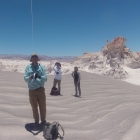"Blown Away"
Blown Away
I review a range of my research topics, with the unifying theme of material transported by wind in planetary environments. Dust devils are a prominent feature of Martian meteorology, appear to have power-law diameter and pressure drop statistics, occasionally clean solar panels and can tell us about the thickness of the planetary boundary layer. On Earth, they are responsible for a few deaths per decade. Recent observations at high elevation (3600m in Argentina, site of giant gravel ripples and yardangs) indicate more frequent occurrence than at sea level – why?
Dune morphology and size also relate to atmospheric parameters, notably the wind direction diversity and the planetary boundary layer thickness. Titan's very regular, large dunes attest to a generally mature pattern in abundant sand (but perhaps formed by rare, violent storms and with a few transitional forms), while Mars' stunted and variable dunes seem off-balance, starved of sediment and still catching up with a changing climate. Earth's diverse and beautiful dune landscapes in the Arabian and Badain Jaran desert provide opportunities to test our understanding.
Aeolian transport on Mars and probably Titan is generally a somewhat rare phenomenon; while simple statistics of Venus observations suggest surface particulates may be in continual motion. These general impressions are of course size-dependent: while dune sands on Earth may move frequently, recent observations show that ~10cm rocks at Racetrack Playa in Death Valley move for about a minute in every million minutes, bulldozed by wind-driven floating ice sheets. The force balance on a wind-driven floating object was first calculated by Edmond Halley, and may one day find application in the exploration of Titan's seas.

